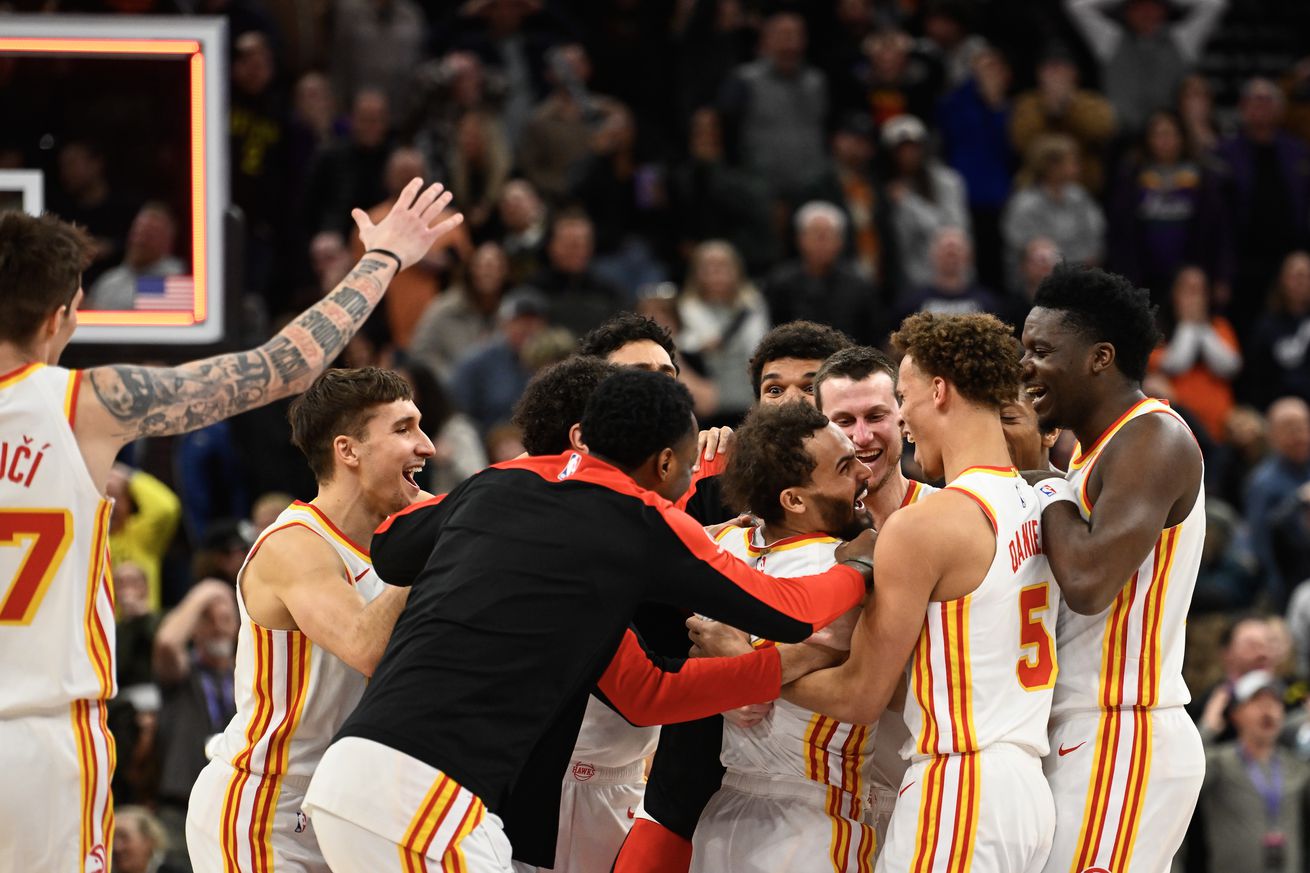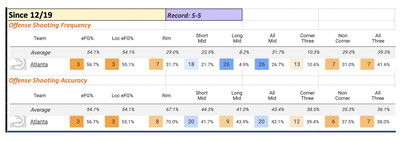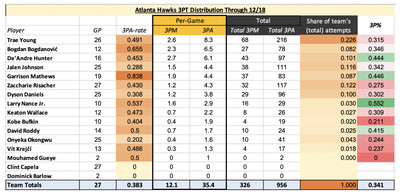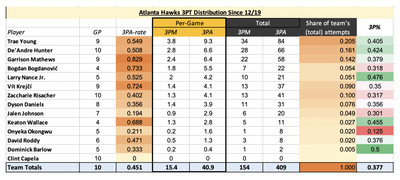
More threes and fewer twos: what this means for the Atlanta Hawks offense.
As we approach the halfway point of the 2024-25 NBA season, the Atlanta Hawks (19-18) may only be sitting one game above the .500 mark in the wins and losses columns. However, the new, fast-paced, unselfish, somewhat frenetic style of play that they’ve adopted this season has begun to win over the fanbase, and made them one of the most exciting young teams* in the entire league.
*Entering the season, the Hawks had the 10th youngest roster in the league (by average age) and as things stand, only Oklahoma City and Memphis entered the season with younger rosters and currently have higher winning percentages than Atlanta (though Detroit (18-18) and San Antonio (18-18) are both hot on their heels)
This season the Hawks are playing faster, sharing the ball more and causing more havoc on the defensive end of the floor than they were in 2023-24, ranking second in the NBA in pace (104.6 possessions per game), third in assist percentage (69.8%), and second in steals (10.3 steals per game) thus far.

As you can see from the table above, though injuries to key players* have led to a few rotational tweaks over the past ten games, this team has doubled down on their efforts in these areas, seeing slight upticks in all three categories over this span.
*The Hawks have been battling the injury bug over their last 10 games, with Jalen Johnson (three games missed), Bogdan Bogdanovic (six games missed), Dyson Daniels (two games missed), Onyeka Okongwu (five games missed), Larry Nance Jr. (five games missed, underwent surgery on broken right hand on Jan. 2nd) and even Trae Young (a game missed) dealing with injuries over this span
In the play below from the last game against Utah, Young pushes the pace off a Sexton make, finding Dyson Daniels for an open drive to the hoop.
From the Clippers game, Dyson and Vit Krejci combine for a pretty give-and-go, leading to a Daniels floater.
From the Toronto game on December 29th, Trae comes up with a steal then finds Jalen streaking down the floor and the possession ends with a rack attack* from Risacher.
It is worth mentioning that the team’s steals average over the past ten games was always going to look pretty good after their incredible 22-steal showing* against the Raptors, however even if you remove that contest from the equation, the Hawks are still averaging 10.3 swipes per game since December 19th — slightly more than their average through the first 27 games of the season.
*A game that Dyson Daniels (their best perimeter defender) was sidelined for, mind you
Still, while the Hawks have maintained their perch near the top of the league in pace, assist percentage and steals over the past few weeks, there has also been one particularly noteworthy change in their recent play as well.
Today, let’s look at how Atlanta’s offense has changed over the past ten games, and what it means for the team going forwards.
Let’s dive in.
More threes, fewer twos
The Atlanta Hawks have seen their offensive rating increase from 110.8 (21st) through the first 27 games of the season to 113.4 (12th) over their last ten — with their uptick in both attempt rate and accuracy from three-point range playing a significant role in this improvement.


As displayed in the tables above from cleaningtheglass (which does not account for garbage time), Atlanta has raised their three-point shooting frequency from 0.366 to 0.416*, and their three-point accuracy from 35.7% to 38% — with both marks placing them in the top-10 in the league since December 19th.
*Taking fewer shots at the Rim and from the short midrange
Per nba.com/stats, the Hawks have canned 15.4 threes per game over their last ten outings, the seventh most made three-pointers per game over this span after making just 12.1 per game (20th) through the first 27 games of the year.
Curious who to thank for the additional makes? The two tables below (numbers from nba.com/stats) compare the Hawks three-point shot distribution (by player) from the beginning of the season to the last ten games.


As you can see, (like most things related to Atlanta’s offense) Trae Young* has been the driving force behind this improvement, shooting a lofty 40.5% from three over his last nine outings while rediscovering the touch on his pull up bombs.
*who has personally accounted for over one-fifth of all of Atlanta’s three-point attempts this season
68 out of Young’s 84 three-point attempts over this stretch have been pull up attempts (7.6 per game) which he’s converted at a ridiculous 44.1% after shooting just 30.1% on these looks (6.3 per game) to start the year. Since December 19th, only Jayson Tatum and Anthony Edwards have splashed more pull up threes than Trae, and they’ve both played more games than him.
While Young’s sharpshooting has obviously been great to see*, he is not the only Hawks who has impressed from the perimeter during this stretch.
*And should (hopefully) help him earn some more clout in the All-Star race. Sidenote: get your votes in, people!
Despite an 0-for-6 hiccup against the Lakers, De’Andre Hunter has continued to shoot the three-ball extremely well — shooting 42.4% on 6.6 attempts a night over the last ten games. Prior to getting hurt, Larry Nance Jr. stepped into the rotation for five games while Onyeka Okongwu was sidelined with an injury of his own, and went 10-for-21 from three over that span*.
*On the season, Nance is shooting a stunning 52% from three (eyes emoji)
Vit Krejci and Garrison Mathews have both gotten some more opportunities in the rotation as of late (due to injuries), and though consistency can be a bit of an issue for both players, they’ve both contributed to the three-point shooting uptick as well, with Mathews shooting 37.9% on 6.4 three-point attempts per game and Krejci shooting 35% on 4.1 three-point attempts per game* over the team’s last ten games.
*Vit is actually in the midst of a mini-heater from the perimeter, going 9-for-18 from three over the Hawks’ last three games (more than half of his threes this season).
While Dyson Daniels and Zaccharie Risacher’s outside shots are very clearly still a work in progress, both starters have also seen their three-point shooting efficiency creep up over this stretch (though both have taken roughly the same number of attempts per game).
It’s no secret that the three-point shot (and more importantly, the threat of a three-point make) is a critical part of every NBA offense in today’s day and age, and while I’m certainly encouraged by the uptick in both perimeter shooting frequency and accuracy from Atlanta over the past few weeks, there is one slight concern.
Pull Up Three Accuracy vs. Catch-and-Shoot Three Accuracy
Not to be a Debbie Downer, but one thing that jumps out from the Hawks’ three-point shooting numbers over the last ten games is that the majority of the improvement we’ve seen in their accuracy has been a result of a massive spike (an increase of nearly 10 percentage points) in their pull up three-point shooting percentage while they’ve only seen a marginal uptick (0.7%) in their catch-and-shoot three-point shooting percentage.

The reason that this is a red flag is because pull up threes are a category that Trae Young dominates — having personally accounted for roughly 60% of the Hawks’ 400 pull up three-point attempts this season* — and given his up-and-down efficiency on these looks this season (discussed in the section above), one has to wonder what will happen to the offense if he goes through another less than impressive shooting stretch.
*Young is 80-for-232 on pull up threes this season, the Hawks with the second-most pull up three-point attempts this season is De’Andre Hunter, who has shot 14-for-32 on these looks.
Nobody else on Atlanta’s roster has the ability to take (forget about make) these looks at the rate that Young is able to, and I worry that the offense could become a bit too reliant on Young pulling a rabbit out of his hat as opposed to a more balanced offensive attack.
Additionally, if Young continues to shoot like this, I’d be very surprised if opposing team’s don’t start to throw more double teams at him going forwards. In these situations, facing two players with the ball in his hands, Young has shown that he’s more than willing to give up the ball and let his teammates play with a four-on-three advantage — which usually leads to an open catch-and-shoot three.
Yet, given that the Hawks rank just 20th in catch-and-shoot three-point accuracy on the season, and haven’t looked that much better over the last ten games, I’m not supremely confident in the team’s ability to consistently make defenses pay in these situations.
It is going to be critical for Atlanta to make strides in this area in order to make the most of Young’s on ball gravity.
Conclusion
The Atlanta Hawks’ three-point shooting turnaround over the past few weeks has been a welcome turn of events for this team. However, while it’s been a lot of fun to watch, I hope I’ve made it clear that despite the uptick in attempt rate and accuracy, there is still room for improvement as far as the team’s overall shooting goes.
I’ll be curious to see if Young can keep up the sky high three-point efficiency, and if he is able to do so, I’ll be watching for how defenses adjust and what the Hawks’ counters will be. In the unfortunate event that Young’s shooting does fall off, it will be interesting to see the impact this might have on the team’s offense.
The Hawks are back in action tonight, facing Phoenix on the final leg of their Western Conference road trip. Tip off is at 9 PM EST on FanDuel Sports Network Southeast!
All statistics/videos used in this article are from cleaningtheglass.com, pbpstats.com, nba.com/stats, bball-index.com, or dunksandthrees.com
